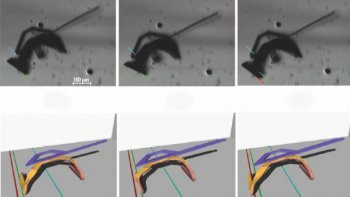Musclebots Take Some Steps
Researchers have let loose scores of walking micromachines made from heart muscle.
Share this:
- Share via email (Opens in new window) Email
- Click to share on Facebook (Opens in new window) Facebook
- Click to share on X (Opens in new window) X
- Click to share on Pinterest (Opens in new window) Pinterest
- Click to share on Reddit (Opens in new window) Reddit
- Share to Google Classroom (Opens in new window) Google Classroom
- Click to print (Opens in new window) Print
By Emily Sohn
You’ve probably heard of robots. Now, make way for musclebots.
Scientists in California have made tiny walking machines out of heart muscle grown from rat cells. When the muscle contracts, then relaxes, the musclebot takes a step. The entire device is tinier than a comma.
Viewed under a microscope, “they move very fast,” says bioengineer Jianzhong Xi of the University of California, Los Angeles (UCLA). “The first time I saw that, it was kind of scary.”
 |
|
A musclebot (bottom left) consists of a bundle of muscle cells attached to a layer of gold, making the device look like a golden arch. This sequence of images shows how a musclebot takes a single step by contracting, then relaxing. The top row shows images of an actual musclebot in action, taken using a microscope. The bottom row illustrates what’s going on as the musclebot contracts and its back leg moves forward (middle), then relaxes to move its front leg forward (right). |
| Jianzhong Xi, Jacob J. Schmidt, and Carlo D. Montmagno, UCLA/Nature Materials |
Scientists have already used muscle tissue to make machines, but these earlier machines were much larger than the new musclebots. A few years ago, for instance, a team at the Massachusetts Institute of Technology made a palm-sized device, called a biomechatronic fish, which swam by using living muscle tissue taken from frogs’ legs.
Adding muscles to a minuscule machine requires a different approach. Instead of using whole tissue, the scientists grew a thin film of heart muscle right on their bot. To do this, they borrowed some methods from the industry that makes chips for computers and other high-tech devices. But these methods can harm cells, so the team also invented some cell-friendly techniques to help do the job.
In the end, the musclebot looks like a golden arch, coated on its inner surface with muscle. Kept alive in a special solution containing glucose, the heart muscle cells beat, causing the bot to scoot along. When the muscle contracts, the arch squeezes together, and the back leg moves forward. When the muscle relaxes, the arch widens, and the front leg moves forward.
Researchers envision a number of applications for the new technology, including musclebots that deliver drugs directly to the cells that need them. They might also be useful for building other tiny machines, converting muscle motion into electric power for microcircuits, or studying muscle tissue.
So far, musclebots can move only in one direction, and they can’t be easily turned on and off. Future versions are sure to be more versatile.—E. Sohn
Going Deeper:
Weiss, Peter. 2005. Micro musclebot: Wee walker moves by heart cells’ beats. Science News 167(Jan. 22):53-54. Available at http://www.sciencenews.org/articles/20050122/fob6.asp .
You can learn more about research on biomechantronic fish at www-personal.umich.edu/~bobden/biomechatronic_devices.html (Bob Dennis, University of Michigan).







